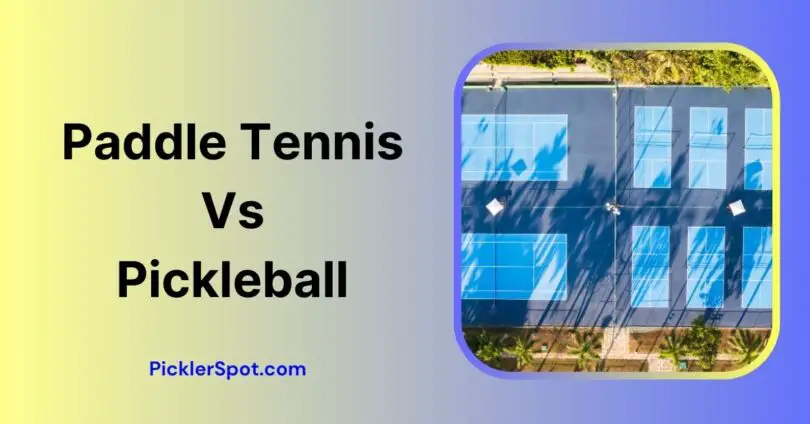Paddle Tennis and Pickleball might look like two peas in a pod but once you glance at their discrepancies you would be astounded to know they are the exact polar opposites.
If you are planning to step into the court and want to go down the route of choosing any of the extracurricular activities mentioned above, it’s pretty evident that you might want to interest yourself with the differences, gameplay style, and core mechanics.
In this article, we are going to delve into intricate details and what sets both of these sports apart, because the last thing you would want is going down the route that clearly doesn’t suit your lifestyle choices.
Paddle Tennis vs Pickleball – What is the Main Difference?
As mentioned above, both of these sports might look similar once looked at a glance, which is why in order for you to understand the key differences, I have categorized the fundamental differences right down below,
1. Core Mechanics
In Pickleball, the serve must hit the ball in an underhand fashion ensuring the paddle remains below the waist. The ball on the other hand must bounce before the non-volley zone and onto the receiver side before it is countered by the receiver.
Depending on the receiver’s playstyle, the counter can usually be either a lob or a Dink which then proceeds the sessions. Meanwhile, volleys can be performed while a player is near the net, where shots like top spins, and groundstrokes with either backhand or forehand are executed.
On the other hand, players in Paddle tennis have to serve with an overhead, however, the only similarity here is that in Paddle tennis, the non-volley rule still applies. Moreover, the serve also has to be served behind the baseline.
Volleys, topspins, and groundstrokes are all applicable forms of execution in Paddle tennis, however, the serve has to be executed in an overhead fashion first.
2. The Equipment Used
Pickleball utilizes an interesting set of equipment which is why pickleball is so addictive. For starters, the paddle is either made from graphite or carbon fiber material and almost resembles a ping pong paddle. As per USAPA rules and regulations, a Paddle must never exceed a length of 17 inches, however, it could be lower than that.
On the other hand, as for the width, it can be of any width as long as it doesn’t break the limit of 8.25 inches. Surprisingly enough, there is no sort of rule that restricts the thickness of the paddle, however, to be on the safe side for power and flexibility, a paddle is usually 0.5-0.6 inches thick with a grip of 5.5 inches.
The game is kept simple by the use of a ball that weighs no more than 1 ounce and is made from hollow synthetic plastic with multiple holes all across its structure that manipulate its trajectory.
Paddle tennis uses a teardrop or diamond-shaped paddle which has a maximum length of 45.5 cm and a width that is no wider than 26 cm all while having a maximum thickness of 38mm.
These teardrop-shaped paddles are also required to have small holes allowing air to pass through them, which gives them a perforated texture. Speaking of perforation, in this game, unlike pickleball, the ball resembles a tennis ball but is much smaller and has a pressurized structure covered in felt and is far slower when it travels across the court.
3. Court Dimensions
In terms of court dimensions, that’s where things usually get interesting because in Pickleball, the court is much smaller and measures at a length of 44 feet all while having a width of 20 feet but then again it is more than enough for such a slow-paced game that requires less maneuvering.
However, the twist here is that the court boasts a 7-foot non-volley zone also known as a kitchen, where the ball cannot be directly volleyed as per the rule of Pickleball and it is present at each side of the court.
Keep in mind that Paddle tennis might be a miniature version of traditional tennis but it still has much bigger dimensions than a pickleball court in fact, it measures a whopping 65 feet long in length while having a width of 33 feet.
4. Scoring System
When it comes to scoring, pickleball uses a different approach in contrast to other sports, in this game, only a server can score a point, and in order for the receiver to score a point they have to win rallies which then allows them to become the server again.
The process is repeated back and forth until one of the teams reaches a scoring capacity of 11 points and wins by a lead of two points.
In Paddle tennis, however, a game is played up to a maximum of 6 points and won at a lead of 2 points. Each game is played in sets and a total of three individual sets are present, so in other words, the best of three sets are played out.
Each point is referred to as “15” and the next increment increases it up to “30”, however, the third point Is “40”. If the score reaches 40-40 the game point is set and now both of the teams are required to score 2 more wins in order to conclude victory.
5. Skill Requirements
Pickleball is highly accessible and caters to almost any person with any skill level, so if you are on the far end of the spectrum, you may be eligible to play pickleball as long as you can pick up a paddle and swing it with enough force to land the ball across the court.
But that’s only in the early phases, the requirements for skillset are certainly too steep when you are learning advanced moves such as learning basic backhand and forehand shots and partaking in rallies.
In Paddle tennis, the learning curve is quite gentle, however, you might be required to use plenty of footwork, so in order you are going to shed plenty of calories as compared to Pickleball.
Is Pickleball Easier Than Tennis?
It goes without saying that pickleball was introduced as a recreational sport back in the 90s to the world, which is why in its essence it has a much shorter and forgiving learning curve when it comes to understanding the basic intricacies of the game. The court is much smaller and the serve system is as simple as it gets.
Tennis on the other hand requires Tons of footwork and has a much bigger court, so you need to calculate your every move accordingly.
Bottom Line
Regardless of the route you choose when picking any of these sports, don’t let its skill requirement intimidate or discourage you into thinking that you may not be eligible to play it.
Regardless of the fact where you lie on the spectrum of your skill, the biggest challenge is usually hitting the court and getting rid of all the anxiety you may have, once you overcome your mental barriers, you will easily learn the ropes and all its esoteric details in no time.
That being said, if you want to know more comparisons such as Paddle Tennis vs. pickleball, let me know in the comment section below, I would be much obliged to shed light on it.









